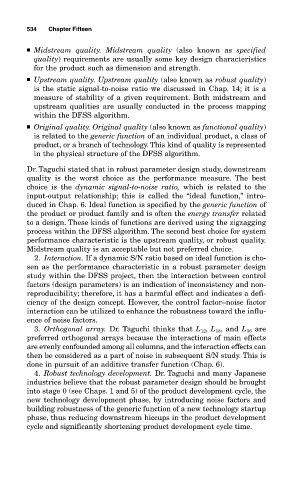Page 576 - Design for Six Sigma a Roadmap for Product Development
P. 576
534 Chapter Fifteen
■ Midstream quality. Midstream quality (also known as specified
quality) requirements are usually some key design characteristics
for the product such as dimension and strength.
■ Upstream quality. Upstream quality (also known as robust quality)
is the static signal-to-noise ratio we discussed in Chap. 14; it is a
measure of stability of a given requirement. Both midstream and
upstream qualities are usually conducted in the process mapping
within the DFSS algorithm.
■ Original quality. Original quality (also known as functional quality)
is related to the generic function of an individual product, a class of
product, or a branch of technology. This kind of quality is represented
in the physical structure of the DFSS algorithm.
Dr. Taguchi stated that in robust parameter design study, downstream
quality is the worst choice as the performance measure. The best
choice is the dynamic signal-to-noise ratio, which is related to the
input-output relationship; this is called the “ideal function,” intro-
duced in Chap. 6. Ideal function is specified by the generic function of
the product or product family and is often the energy transfer related
to a design. These kinds of functions are derived using the zigzagging
process within the DFSS algorithm. The second best choice for system
performance characteristic is the upstream quality, or robust quality.
Midstream quality is an acceptable but not preferred choice.
2. Interaction. If a dynamic S/N ratio based on ideal function is cho-
sen as the performance characteristic in a robust parameter design
study within the DFSS project, then the interaction between control
factors (design parameters) is an indication of inconsistency and non-
reproducibility; therefore, it has a harmful effect and indicates a defi-
ciency of the design concept. However, the control factor–noise factor
interaction can be utilized to enhance the robustness toward the influ-
ence of noise factors.
3. Orthogonal array. Dr. Taguchi thinks that L 12 , L 18 , and L 36 are
preferred orthogonal arrays because the interactions of main effects
are evenly confounded among all columns, and the interaction effects can
then be considered as a part of noise in subsequent S/N study. This is
done in pursuit of an additive transfer function (Chap. 6).
4. Robust technology development. Dr. Taguchi and many Japanese
industries believe that the robust parameter design should be brought
into stage 0 (see Chaps. 1 and 5) of the product development cycle, the
new technology development phase, by introducing noise factors and
building robustness of the generic function of a new technology startup
phase, thus reducing downstream hiccups in the product development
cycle and significantly shortening product development cycle time.

